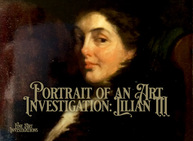The art investigation into the life of Lilian dePeyster Post Pulsford Walker clarified why such a lovely portrait was sent to the auction block as a painting by an unknown artist, but had not revealed the artist. I returned to the two original clues. The first clue was an initial and name, probably inscribed by the artist. on the top canvas edge.

The second clue was Lilian’s married name with the initials of her first husband, John Arthur Pulsford. Sometimes I picture Arthur drunkenly adding “Mrs.” and his name to the side of the canvas to show his possession of her.

In 1910, Lilian told Arthur she would to go to the ends of the earth to get rid of his name — and she did — if Omaha, Nebraska, and Reno, Nevada, were the ends of the earth to a New Yorker. Surely she would have erased that name if she had taken the painting with her. When she left Arthur in 1909, did she leave her portrait behind?
When Arthur Pulsford died at the age of 52, just six years after the messy, public divorce, he left everything to his sister Josephine, an unmarried school teacher.((Last Will and Testament of J. Arthur Pulsford, unsourced, emailed by Lisa Taylor Brophy, Esq., Staff Attorney, Union County Surrogate, 2 Broad Street, Elizabeth, NJ 07207, October 28, 2014.))
What happened to the portrait after his death in 1921 can only be surmised. Sometime before 2014, the painting became part of an art collection administered by the Jean and Graham Devoe Williford Charitable Trust of Fairfield, Texas. Graham Devoe Williford (1926-2006) was a leading art collector. Mona Jean Devoe (Mrs. Carl N. Williford) was his mother. “For more than 50 years, Graham Williford was a fixture on the New York gallery scene,” He was “a pioneer collector “of American painting and sculpture for the period 1850-1920…He developed a particular affection for the work of American expatriate artists” who, ‘sought training and inspiration beyond the borders of the United States…Attributes he most prized: good composition, excellent draftsmanship, confident broad brushwork, and subtle color harmonies.”((Marianne Berardi, “Across the Pond and Back and Back Again,” Catalogue entry for Fine & Decorative Art Including The Gentleman Collector Signature Estate Auction, Heritage Auctions, September 14, 2014, http://fineart.ha.com/information/pond.s, accessed February, 2015. Additional information Tyler Museum of Art, “The Collector,” The Elegant House: Paintings & Decorative Art from the Graham Williford Collection, (November 16, 2008–March 1, 2009), http://www.tylermuseum.org/TheElegantHouse.aspx, accessed February, 2015)) This clue confirmed the artist’s talent, but gave no help with the identification.
Integral to an art investigation, is grounding the artwork in place and time. The place was probably in or around New York City because the Pulsfords lived in Elizabeth, New Jersey, a suburb of the metropolis. From Lilian’s life story, The time the artist painted the portrait was after Lilian’s marriage in 1896 and before 1913, when she left Pulsford. I narrowed the date to around 1902 by comparing the sitter’s clothing with fashions worn in dated paintings or photographs. Two photographs of Alice Roosevelt established a date of around 1902. Whose style better for Lilian to emulate than the daughter of the President, Theodore Roosevelt?

Lilian De Peyster Post Pulsford
Oil on Canvas, 18 x 22 inches Private Collection
Frances B. Johnston, Alice Roosevelt, 1902
Library of Congress Prints and Photographs Division
Washington, D.C. LC-USZC2-6252
Frances B. Johnston, Alice Roosevelt, 1902
Library of Congress Prints and Photographs DivisionWashington, D.C. LC-USZC2-6251
The next question was, “who was the artist?” Was it Cecilia Beaux? Surely she and Lilian would have admired one another. John Singer Sargent? John White Alexander? Alexander was a favorite choice of portraitist for insurance executives like J. A. Pulsford. Many of the famed Gilded Age artists trained at the same schools, knew one another, shared techniques. I sought the help of a specialist in Gilded Age portraiture who suggested Wilhelm Heinrich Funk. Who?
To be absolutely clear, there is no proof that Wilhelm Heinrich Funk was the artist of the portrait of Lilian dePeyster Post Pulsford Walker. But, he was a fine artist with a comparable style. Why was he forgotten? His life story rivals Lilian’s and contains the answer.
Previous: Portrait of an Art Investigation – Lilian II
Next: Portrait of an Art Investigation – Lilian IV

